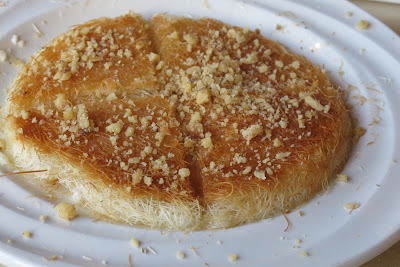 The tourists who flock to this Druze Arabic style restaurant get a menu in Hebrew where the only thing I could read was the prices. There is an outside eating area
The tourists who flock to this Druze Arabic style restaurant get a menu in Hebrew where the only thing I could read was the prices. There is an outside eating area  and a modest size well patronized inside area with good size tables, which is essential for a comfortable meal.
and a modest size well patronized inside area with good size tables, which is essential for a comfortable meal. Fortunately ordering is extremely simple. Salads, which are in abundance,
Fortunately ordering is extremely simple. Salads, which are in abundance,

 don't need to be ordered, humus
don't need to be ordered, humus and tahina are brought to the table,
and tahina are brought to the table, of course you can refuse anything you do not like. There is a standard approach to meals. Small plates of a variety of salads are brought to the table in rapid succession with pita bread.
of course you can refuse anything you do not like. There is a standard approach to meals. Small plates of a variety of salads are brought to the table in rapid succession with pita bread.  The main course may be fish, meat or fowl served on a shashlik skewer, as cutlets, meat balls, small fillets, mince or in the case of fish grilled or baked whole. Tastes vary from restaurant to restaurant, especially in regard to amounts of lemon and salt used, the olive oil used with the humus and the texture of the humus which can be quite coarse or extremely creamy. Sandra prefers the smoothest possible whilst I prefer a more grainy texture.
The main course may be fish, meat or fowl served on a shashlik skewer, as cutlets, meat balls, small fillets, mince or in the case of fish grilled or baked whole. Tastes vary from restaurant to restaurant, especially in regard to amounts of lemon and salt used, the olive oil used with the humus and the texture of the humus which can be quite coarse or extremely creamy. Sandra prefers the smoothest possible whilst I prefer a more grainy texture.
 At this restaurant the tahina was extremely salty. All the vegetable and meat dishes were as they usually are but there was one enormous surprise. The menu included goose liver foie gras. For about A$15 a skewer with half a dozen lightly grilled large pieces of sensational liver was delivered to the table exactly how we asked it to be cooked. The fish was cooked in a tagine
At this restaurant the tahina was extremely salty. All the vegetable and meat dishes were as they usually are but there was one enormous surprise. The menu included goose liver foie gras. For about A$15 a skewer with half a dozen lightly grilled large pieces of sensational liver was delivered to the table exactly how we asked it to be cooked. The fish was cooked in a tagine  on a bed of red and yellow peppers with potato and served with half a lemon. I had St. Peters fish also known here as Musht and Amnon.
on a bed of red and yellow peppers with potato and served with half a lemon. I had St. Peters fish also known here as Musht and Amnon.  This fish is a Nth African river fish of the Tilapia family. It was brought to Australia as a tropical aquarium fish but , by accident or intention, got into the waterways of Queensland and NSW. It is regarded as one of the most noxious species in Australia and in NSW possession of this fish can be penalised with a fine of up to $11,000. On the positive side it is a fine white fleshed fish which has soft bones, and a lot of them. It has to be eaten with care but I think it worth the effort. We enjoyed two great desserts. The best one was Lebanon Nights, also known as Nights of Beirut. Basically made from milk, sugar, either rice or cornflower with rose water and pistachio nuts, with or without almonds, and set like a pannacotta it was silky smooth, gently flavoured and very moorish (and Moorish I guess). This was a variation using sago and sat on a thick sweet mouth watering cream
This fish is a Nth African river fish of the Tilapia family. It was brought to Australia as a tropical aquarium fish but , by accident or intention, got into the waterways of Queensland and NSW. It is regarded as one of the most noxious species in Australia and in NSW possession of this fish can be penalised with a fine of up to $11,000. On the positive side it is a fine white fleshed fish which has soft bones, and a lot of them. It has to be eaten with care but I think it worth the effort. We enjoyed two great desserts. The best one was Lebanon Nights, also known as Nights of Beirut. Basically made from milk, sugar, either rice or cornflower with rose water and pistachio nuts, with or without almonds, and set like a pannacotta it was silky smooth, gently flavoured and very moorish (and Moorish I guess). This was a variation using sago and sat on a thick sweet mouth watering cream A Katafia was, for once, not deconstructed.
A Katafia was, for once, not deconstructed. Prices are very low for a very decent meal. Service is desparate to please with great Middle Eastern hospitality.
Prices are very low for a very decent meal. Service is desparate to please with great Middle Eastern hospitality.Score: 13.75/20


No comments:
Post a Comment